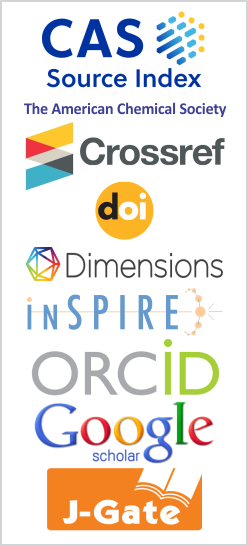Study of Effects of Hot Phonon on Hot Electron Transport
DOI:
https://doi.org/10.26713/jamcnp.v6i3.1292Keywords:
Hot electron, Monte Carlo simulation, Phonon populationAbstract
We study the influence of hot phonons on hot electron transport within the drain region is investigated. The ensemble Monte Carlo (MC) method self-consistently coupled with Poisson's equation is used. This MC simulation is three-dimensional in k-space and two-dimensional in real space. The two-dimensional model is possible if physical quantities have no significant variation along the third direction. The phonon Boltzmann transport equation (BTE) is solved and the mean heat generation rate is calculated.
Downloads
References
Y. S. Ju and K. E. Goodson, Phonon scattering in silicon films with thickness of order 100 nm, Appl. Phys. Lett. 74(20), 3005 (1999), DOI: 10.1063/1.123994.
A. Svizhenko and M. P. Anantram, Role of scattering in nanotransistors, IEEE Trans. Electron Devices 50, 1459 (2003), DOI: 10.1109/TED.2003.813503.
W. Pötz and P. Kocevar, Electronic power transfer in pulsed laser excitation of polar semiconductors, Phys. Rev. B 28, 7040 (1983), DOI: 10.1103/PhysRevB.28.7040.
D. Y. Oberli, G. Böhm and G. Weimann, Role of interface optical phonons in cooling hot carriers in GaAs-AlAs quantum wells, Phys. Rev. B 47, 7630 (1993), DOI: 10.1103/PhysRevB.47.7630.
N. S. Mansour, Y. M. Sirenko, K. W. Kim, M. A. Littlejohn, J. Wang and J. P. Leburton, Carrier capture in cylindrical quantum wires, Appl. Phys. Lett. 67, 3480 (1995), DOI: 10.1063/1.115253.
S. Koch, T. Waho and T. Mizutani, InGaAs resonant tunneling transistors using a coupledquantum-well base with strained AlAs tunnel barriers, IEEE Trans. Electron Devices 41, 1498 (1994), DOI: 10.1109/16.310099.
K. Kurishima, H. Nakajima, T. Kobayashi, Y. Matsuoka and T. Ishibashi, Fabrication and characterization of high-performance InP/InGaAs double-heterojunction bipolar transistors, IEEE Trans. Electron Devices 41, 1319 (1994), DOI: 10.1109/16.297724.
K. Tomizawa. Numerical Simulation of Submicron Semiconductor Devices, Artec House, London (1993).
M. Lundstrom, Fundamentals of Carrier Transport, Cambridge University Press (2000).
C. Jacoboni and L. Reggiani, The Monte Carlo method for the solution of charge transport in semiconductors with applications to covalent materials, Rev. Mod. Phys. 55, 645 (1983), DOI: 10.1103/RevModPhys.55.645.
C. Hamaguchi, Quantum structures, in Basic Semiconductor Physics, Springer (2001), DOI: 10.1007/978-3-662-04656-2_8.
E. Pop, R. W. Dutton and K. E. Goodson, Analytic band Monte Carlo model for electron transport in Si including acoustic and optical phonon ispersion, J. Appl. Phys. 96, 4998 (2004), DOI: 10.1063/1.1788838.
W. Cai, C. M. Marchetti and M. Lax, Nonequilibrium phonon effect on time-dependent relaxation of hot electrons in semiconductor heterojunctions, Phys. Rev. B 35, 1369 (1987), DOI: 10.1103/PhysRevB.35.1369.
Ole Christian Norum, Monte Carlo Simulation of Semiconductors–Program Structure and Physical Phenomena, Master's Thesis, Norwegian University of Science and Technology, (2009), http://hdl.handle.net/11250/246281.
J.-P. Gaspard, A. Pellegatti, F. Marinelli and C. Bichara, Peierls instabilities in covalent structures I. Electronic structure, cohesion and the Z = 8−N rule, Philos. Mag. B77, 727 (1998), DOI: 10.1080/13642819808214831.
J. Zhang, W. Cui, M. Juda, D. McCammon, R.L. Kelley, S. H. Moseley, C. K. Stahle and A. E. Szymkowiak, Non-Ohmic effects in hopping conduction in doped silicon and germanium between 0.05 and 1 K, Phys. Rev. B 57, 4472 – 4481 (1998), DOI: 10.1103/PhysRevB.57.4472.
J. C. Mather, Bolometer noise: nonequilibrium theory, Appl. Opt. 21, 1125 – 1129 (1982), DOI: 10.1364/AO.21.001125.
S. H. Moseley, J. C. Mather and D. McCammon, Thermal detectors as xray spectrometers, J. Appl. Phys. 56, 1257 – 1262 (1984), DOI: 10.1063/1.334129.
W. A. Little, The transport of heat between dissimilar solids at low temperatures, Can. J. Phys. 37, 334 – 349 (1959), DOI: 10.1139/p59-037.
Downloads
Published
How to Cite
Issue
Section
License
Authors who publish with this journal agree to the following terms:- Authors retain copyright and grant the journal right of first publication with the work simultaneously licensed under a CCAL that allows others to share the work with an acknowledgement of the work's authorship and initial publication in this journal.
- Authors are able to enter into separate, additional contractual arrangements for the non-exclusive distribution of the journal's published version of the work (e.g., post it to an institutional repository or publish it in a book), with an acknowledgement of its initial publication in this journal.
- Authors are permitted and encouraged to post their work online (e.g., in institutional repositories or on their website) prior to and during the submission process, as it can lead to productive exchanges, as well as earlier and greater citation of published work.




